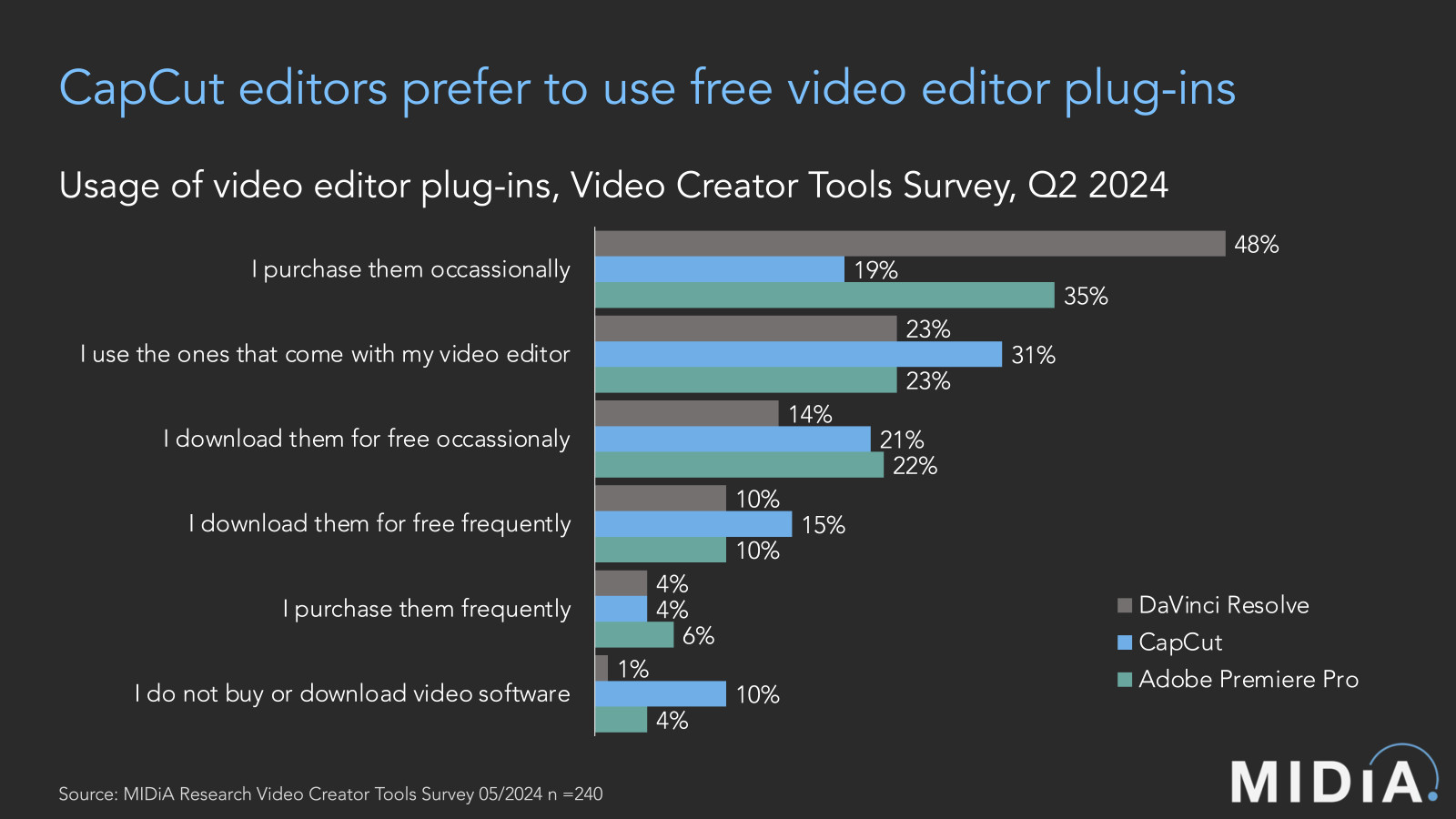The video creator economy’s challenge: not all creators want to pay for editing tools

Photo: Ben Woods

Video creation has never been more accessible. More and more entertainment consumers are shifting from passive to lean-through consumption by creating their own content. However, those creators have different priorities from professional editors and videographers who have made up the video creator economy for decades. In MIDiA’s recently published State of the Video Creator Economy report, we describe how the video economy was trifurcated into social video creators, marketing creators, and TV and movie creators. Each of these creator types has different needs when it comes to creator tools. Each wants varying degrees of speed and control: marketing creators are willing to sacrifice some creative control in favour of getting to their target audience faster. Movie editors want to remove laborious tasks, but not at the expense of being able to fine tune their output.
However, these differences are not just limited to creation. How and what video creators are willing to pay for also changes based on whether they are a social video, marketing, or TV and movie creator. Encouragingly for software companies that have expanded beyond professional creators to capture social video creators, creator tools remain a key monetisation driver: 23% of consumers said they would be willing to pay for editing tools in Q1, 2024. This was the most popular option when asked what features they would pay for on social platforms, compared to the likes of exclusive creator content, advert-free browsing, or custom emojis and stickers. While underscoring the strong monetisation potential of creative tools, the picture looks more complex when focusing on types of tools and frequency of purchase.
CapCut users have a different monetisation mindset
This is certainly the case for users of video editor plug-ins across Adobe Premiere Pro, DaVinci Resolve, and CapCut. The most common behaviour for users of Adobe Premiere Pro and DaVinci Resolve was to buy video editor plug-ins occasionally at 35% and 48% respectively in Q2, 2024. This is not the case for CapCut editors. Their most common behaviour was to use the features that came with the editor (31%) and were more likely to download free video editor plug-ins frequently at 15% compared to Adobe Premiere Pro (10%) and DaVinci (10%) users. This preference for free over paid poses a monetisation challenge, especially as CapCut users skew younger than Adobe Premiere Pro and DaVinci Resolve users. How do you ensure the next generation of creators is just as hungry to buy software as the last?
Featured Report
MIDiA Research 2025–2031 music creator tools forecasts AI comes to town
This music creator tools forecasts report acts as a companion piece to MIDiA’s report “State of music creator economy: AI’s growing reach ” . This report provides analysis, market sizing, and forecasts...
Find out more…The free tools challenge
Editing software will have to contend with the growing trend among social platforms to use free creative tools as user acquisition and retention drivers. Freemium services are nothing new. DaVinci Resolve offers a free tier, and nearly half of its users buy video editor plug-ins occasionally. The problem comes when the free tools on offer are able to satisfy all of a creator’s needs. Features are the biggest motivator for creators when buying tools. They far outweigh the cost advantages of subscriptions. In fact, many professional creators still prefer to own their software rather than paying for subscriptions to it. Moreover, Gen Z has less brand loyalty and are fickler with their purchasing habits. They are driven by creative need: often paying for a subscription to access one tool before churning after a month’s use. Pointing to the variety of tools on offer through a single subscription offer may struggle to cut through for younger creators focused on short-term outcomes. The option of buying individual tools through in-app purchases may prove more appealing to this demographic, especially as younger creators have less disposable income.
Creator understanding remains key
CapCut’s close alignment with TikTok through its ByteDance ownership provides enough of a funnel to forego some users focusing on free tools alone. By closely aligning post-production with distribution, CapCut can also create a positive feedback loop where users wanting to replicate TikTok trends using CapCut Pro tools will have to upgrade to a monthly subscription of £10.99. While powerful when it happens, this marketing boost for feature upsells remains at the whim of when creators decide to use them.
Ultimately, software providers need to apply the same level of flexibility with monetisation as they have for creator workflows if they want to maintain long-lasting engagement with social and professional creators alike. Understanding creator needs is paramount. While a subscription offer may feel like a sensible one-size fits all approach, it may struggle to convince the next generation of social video creators brought up on a diet of free tools and free content.
· For a deep dive into how video creators use software tools, stay tuned for MIDiA’s Video Creator Tools: Software user profile published in August, 2024.

The discussion around this post has not yet got started, be the first to add an opinion.